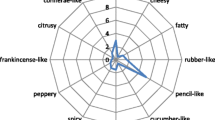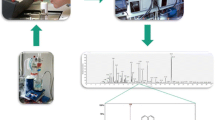Abstract
Over the centuries, oak wood has been used in the maturation process of alcoholic beverages imparting aroma and flavor notes. Whereas several studies have dealt with the impact of oak wood on the chemical composition of, for example, wine aroma, only limited information is available on the odorant composition of unmodified and raw oak wood itself. To close this gap, a combination of human sensory and chemo-analytical techniques was applied for the elucidation of the chemical composition of oak odor, comprising extraction of the volatile fraction of oak wood by means of solvent-assisted flavor evaporation (SAFE) and subsequent mild concentration of the distillate. Odor extract dilution analysis (OEDA), which is based on gas chromatography-olfactometry (GC-O), was then applied for the targeted characterization of the odor-active compounds. Overall, a total of 97 odorants was identified via gas chromatography-mass spectrometry/olfactometry (GC-MS/O) and heart-cut two-dimensional gas chromatography-mass spectrometry/olfactometry (2D-GC-MS/O). The majority of these odorants comprised a series of terpenes, mainly mono- and sesquiterpenes, aldehydes, acids, and lactones, as well as a number of odorants containing a phenolic core moiety. Several odorants are reported here for the first time as volatile organic compounds in oak wood. Identification of the molecular composition of oak wood odor helps to establish a better understanding of the distinctive smell of oak wood, and offers the basis for unveiling its potential effects on humans when being exposed to oak wood smell in daily life.

ᅟ


Similar content being viewed by others
References
Flamini R, Dalla Vedova A, Cancian D, Panighel A, De Rosso M. GC/MS-positive ion chemical ionization and MS/MS study of volatile benzene compounds in five different woods used in barrel making. J Mass Spectrom. 2007;42(5):641–6. https://doi.org/10.1002/jms.1193.
De Rosso M, Cancian D, Panighel A, Dalla Vedova A, Flamini R. Chemical compounds released from five different woods used to make barrels for aging wines and spirits: volatile compounds and polyphenols. Wood Sci Technol. 2009;43(5):375–85. https://doi.org/10.1007/s00226-008-0211-8.
González-Rodríguez J, Pérez-Juan P, Luque de Castro MD. Extraction of wood compounds by use of subcritical fluids. Chromatographia. 2003;57(5):363–8. https://doi.org/10.1007/bf02492409.
Pérez-Coello MS, Sanz J, Cabezudo MD. Gas chromatographic-mass spectrometric analysis of volatile compounds in oak wood used for ageing of wines and spirits. Chromatographia. 1998;47(7):427. https://doi.org/10.1007/bf02466474.
Culleré L, Fernández de Simón B, Cadahía E, Ferreira V, Hernández-Orte P, Cacho J. Characterization by gas chromatography–olfactometry of the most odor-active compounds in extracts prepared from acacia, chestnut, cherry, ash and oak woods. LWT Food Sci Technol. 2013;53(1):240–8. https://doi.org/10.1016/j.lwt.2013.02.010.
Sefton MA, Francis IL, Williams PJ. Volatile norisoprenoid compounds as constituents of oak woods used in wine and spirit maturation. J Agric Food Chem. 1990;38(11):2045–9. https://doi.org/10.1021/jf00101a009.
Anjos O, Carmona C, Caldeira I, Canas S. Variation of extractable compounds and lignin contents in wood fragments used in the aging of wine brandies. Bioresources. 2013;8(3):4484–96.
Prida A, Puech J-L. Influence of geographical origin and botanical species on the content of extractives in American, French, and east European oak woods. J Agric Food Chem. 2006;54(21):8115–26. https://doi.org/10.1021/jf0616098.
Fernández de Simón B, Cadahía E, Jalocha J. Volatile compounds in a Spanish red wine aged in barrels made of Spanish, French, and American oak wood. J Agric Food Chem. 2003;51(26):7671–8. https://doi.org/10.1021/jf030287u.
Mosedale JR, Savill PS. Variation of heartwood phenolics and oak lactones between the species and phenological types of Quercus petraea and Q. Robur. Forestry. 1996;69(1):47–55.
Gallego L, Alamo MD, Nevares I, Fernández J, Fernández de Simón B, Cadahía E. Phenolic compounds and sensorial characterization of wines aged with alternative to barrel products made of Spanish oak wood (Quercus pyrenaica Willd.). Food Sci Technol Int. 2012;18(2):151–65. https://doi.org/10.1177/1082013211427782.
Doussot F, De Jéso B, Quideau S, Pardon P. Extractives content in cooperage oak wood during natural seasoning and toasting; influence of tree species, geographic location, and single-tree effects. J Agric Food Chem. 2002;50(21):5955–61. https://doi.org/10.1021/jf020494e.
Fernández de Simón B, Cadahía E, Sanz M, Poveda P, Perez-Magariño S, Ortega-Heras M, et al. Volatile compounds and sensorial characterization of wines from four Spanish denominations of origin, aged in Spanish Rebollo (Quercus pyrenaica Willd.) oak wood barrels. J Agric Food Chem. 2008;56(19):9046–55. https://doi.org/10.1021/jf8014602.
Cabrita MJ, Barrocas Dias C, Costa Freitas AM. Phenolic acids, phenolic aldehydes and Furanic derivates in oak chips: American vs. French Oaks. S Afr J Enol Vitic. 2011;32(2):204–10.
Vichi S, Santini C, Natali N, Riponi C, López-Tamames E, Buxaderas S. Volatile and semi-volatile components of oak wood chips analysed by accelerated solvent extraction (ASE) coupled to gas chromatography–mass spectrometry (GC–MS). Food Chem. 2007;102(4):1260–9. https://doi.org/10.1016/j.foodchem.2006.07.023.
Fernández de Simón B, Cadahía E, del Álamo M, Nevares I. Effect of size, seasoning and toasting in the volatile compounds in toasted oak wood and in a red wine treated with them. Anal Chim Acta. 2010;660(1):211–20. https://doi.org/10.1016/j.aca.2009.09.031.
Jordão AM, Ricardo-da-Silva JM, Laureano O, Adams A, Demyttenaere J, Verhé R, et al. Volatile composition analysis by solid-phase microextraction applied to oak wood used in cooperage (Quercus pyrenaica and Quercus petraea): effect of botanical species and toasting process. J Wood Sci. 2006;52(6):514–21. https://doi.org/10.1007/s10086-005-0796-6.
Cutzach I, Chatonnet P, Henry R, Dubourdieu D. Identification of volatile compounds with a “toasty” aroma in heated oak used in Barrelmaking. J Agric Food Chem. 1997;45(6):2217–24. https://doi.org/10.1021/jf960947d.
Prida A, Ducousso A, Petit RJ, Nepveu G, Puech J-L. Variation in wood volatile compounds in a mixed oak stand: strong species and spatial differentiation in whisky-lactone content. Ann For Sci. 2007;64(3):313–20. https://doi.org/10.1051/forest:2007008.
Chatonnet P, Cutzach I, Pons M, Dubourdieu D. Monitoring toasting intensity of barrels by chromatographic analysis of volatile compounds from toasted oak wood. J Agric Food Chem. 1999;47(10):4310–8. https://doi.org/10.1021/jf981234t.
Li S, Crump AM, Grbin PR, Cozzolino D, Warren P, Hayasaka Y, et al. Aroma potential of oak battens prepared from decommissioned oak barrels. J Agric Food Chem. 2015;63(13):3419–25. https://doi.org/10.1021/acs.jafc.5b00339.
Nonier M-F, De Gaulejac NV, Vivas N, Vitry C. Characterization of carotenoids and their degradation products in oak wood. Incidence on the flavour of wood. C R Chim. 2004;7(6):689–98. https://doi.org/10.1016/j.crci.2004.03.010.
Díaz-Maroto MC, Guchu E, Castro-Vázquez L, de Torres C, Pérez-Coello MS. Aroma-active compounds of American, French, Hungarian and Russian oak woods, studied by GC–MS and GC–O. Flavour Fragr J. 2008;23(2):93–8. https://doi.org/10.1002/ffj.1859.
Engel W, Bahr W, Schieberle P. Solvent assisted flavour evaporation—a new and versatile technique for the careful and direct isolation of aroma compounds from complex food matrices. Eur Food Res Technol. 1999;209(3-4):237–41. https://doi.org/10.1007/s002170050486.
Bemelmans JMH. Review of isolation and Concentation techniques. London: Prog. Flavour Res.. Applied Science Publ; 1979.
van Den Dool H, Kratz PD. A generalization of the retention index system including linear temperature programmed gas—liquid partition chromatography. J Chromatogr A. 1963;11:463–71. https://doi.org/10.1016/s0021-9673(01)80947-x.
Grosch W. Evaluation of the key odorants of foods by dilution experiments, aroma models and omission. Chem Senses. 2001;26(5):533–45. https://doi.org/10.1093/chemse/26.5.533.
Buettner A, Schieberle P. Application of a comparative aroma extract dilution analysis to monitor changes in Orange juice aroma compounds during processing. In: Gas chromatography-Olfactometry, vol 782. ACS Symposium Series, vol 782. J Am Chem Soc. 2001;33–45. https://doi.org/10.1021/bk-2001-0782.ch004.
Hinterholzer A, Schieberle P. Identification of the most odour-active volatiles in fresh, hand-extracted juice of Valencia late oranges by odour dilution techniques. Flavour Fragr J. 1998;13(1):49–55. https://doi.org/10.1002/(SICI)1099-1026(199801/02)13:1<49::AID-FFJ691>3.0.CO;2-S.
Czerny M, Buettner A. Odor-active compounds in cardboard. J Agric Food Chem. 2009;57(21):9979–84. https://doi.org/10.1021/jf901435n.
Laska M, Hudson R. A comparison of the detection thresholds of odour mixtures and their components. Chem Senses. 1991;16(6):651–62. https://doi.org/10.1093/chemse/16.6.651.
Miyazawa T, Gallagher M, Preti G, Wise PM. Synergistic mixture interactions in detection of perithreshold odors by humans. Chem Senses. 2008;33(4):363–9. https://doi.org/10.1093/chemse/bjn004.
Guadagni DG, Buttery RG, Okano S, Burr HK. Additive effect of sub-threshold concentrations of some organic compounds associated with food aromas. Nature. 1963;200:1288. https://doi.org/10.1038/2001288a0.
Milanos S, Elsharif SA, Janzen D, Buettner A, Villmann C. Metabolic products of linalool and modulation of GABA(a) receptors. Front Chem. 2017;5:46. https://doi.org/10.3389/fchem.2017.00046.
Kessler A, Sahin-Nadeem H, Lummis SC, Weigel I, Pischetsrieder M, Buettner A, et al. GABA(A) receptor modulation by terpenoids from Sideritis extracts. Mol Nutr Food Res. 2014;58(4):851–62. https://doi.org/10.1002/mnfr.201300420.
Kessler A, Villmann C, Sahin-Nadeem H, Pischetsrieder M, Buettner A. GABAA receptor modulation by the volatile fractions of Sideritis species used as ‘Greek’ or ‘Turkish’ mountain tea. Flavour Fragr J. 2012;27 https://doi.org/10.1002/ffj.3099.
Bordiga M, Piana G, Coïsson JD, Travaglia F, Arlorio M. Headspace solid-phase micro extraction coupled to comprehensive two-dimensional with time-of-flight mass spectrometry applied to the evaluation of Nebbiolo-based wine volatile aroma during ageing. Int J Food Sci Technol. 2014;49(3):787–96. https://doi.org/10.1111/ijfs.12366.
Rogachev AD, Salakhutdinov NF. Chemical composition of Pinus sibirica (Pinaceae). Chem Biodivers. 2015;12(1):1–53. https://doi.org/10.1002/cbdv.201300195.
Schreiner L, Loos HM, Buettner A. Identification of odorants in wood of Calocedrus decurrens (Torr.) florin by aroma extract dilution analysis and two-dimensional gas chromatography–mass spectrometry/olfactometry. Anal Bioanal Chem. 2017;409(15):3719–29. https://doi.org/10.1007/s00216-017-0314-x.
Niebler J, Zhuravlova K, Minceva M, Buettner A. Fragrant Sesquiterpene ketones as trace constituents in frankincense volatile oil of Boswellia sacra. J Nat Prod. 2016;79(4):1160–4. https://doi.org/10.1021/acs.jnatprod.5b00836.
Setze WN. Volatile components of oak and cherry wood chips used in aging of beer, wine, and sprits. Am J Essent Oil Nat Prod. 2016;4(2):37–40.
Roffael E, Schneider T, Dix B. Effect of oxidising and reducing agents on the release of volatile organic compounds (VOCs) from strands made of Scots pine (Pinus sylvestris L.). Wood Sci Technol. 2015;49(5):957–67. https://doi.org/10.1007/s00226-015-0744-6.
Sjöström E. Wood chemistry: Fundamentals and applications. New York: Academic; 1981.
Rodríguez Madrera R, Blanco Gomis D, Mangas Alonso JJ. Influence of distillation system, oak wood type, and aging time on composition of cider brandy in phenolic and Furanic compounds. J Agric Food Chem. 2003;51(27):7969–73. https://doi.org/10.1021/jf0347618.
Alañón ME, Ramos L, Díaz-Maroto MC, Pérez-Coello MS, Sanz J. Extraction of volatile and semi-volatile components from oak wood used for aging wine by miniaturised pressurised liquid technique. Int J Food Sci Technol. 2009;44(9):1825–35. https://doi.org/10.1111/j.1365-2621.2009.02006.x.
Pe’rez-Coello MS, Sanz J, Cabezudo MD. Analysis of volatile components of oak wood by solvent extraction and direct thermal desorption-gas chromatography-mass spectrometry. J Chromatogr A. 1997;778(1):427–34. https://doi.org/10.1016/S0021-9673(97)00286-0.
Puech J-L. Phenolic compounds in oak wood extracts used in the ageing of brandies. J Sci Food Agric. 1988;42(2):165–72. https://doi.org/10.1002/jsfa.2740420209.
Grote V. Positive health effects of stone pine furniture and bioinhibitoric effect. Joanneum Research; Springer Pub. Co., J. Hum. Res . 2015.
Acknowledgements
The authors would like to thank the sensory panelists from Fraunhofer IVV. We would also like to thank the Staedtler foundation for financial support of this study.
Funding
Staedtler foundation provided financial support of this study.
Author information
Authors and Affiliations
Corresponding author
Ethics declarations
Conflict of interest
The authors declare that they have no conflict of interest.
Ethical statement
The study was conducted in agreement with the Declaration of Helsinki. The study (registration number 180_16B) was approved by the Ethical Committee of the Medical Faculty, Friedrich-Alexander Universität Erlangen-Nürnberg. Informed consent was obtained from all subjects participating in the study.
About this article
Cite this article
Ghadiriasli, R., Wagenstaller, M. & Buettner, A. Identification of odorous compounds in oak wood using odor extract dilution analysis and two-dimensional gas chromatography-mass spectrometry/olfactometry. Anal Bioanal Chem 410, 6595–6607 (2018). https://doi.org/10.1007/s00216-018-1264-7
Received:
Revised:
Accepted:
Published:
Issue Date:
DOI: https://doi.org/10.1007/s00216-018-1264-7




